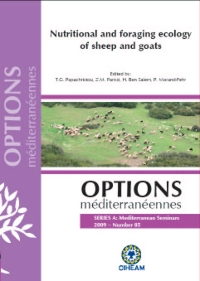| Article précédent | p. 43-48 | Article suivant |
The anthelmintic effect of heather supplementation may not always be associated with antinutritional effects in grazing goats
To test the hypothesis that the beneficial anthelmintic effect of the consumption of moderate amounts of tannins is not always accompanied by anti-nutritional effects, we used 48 Cashmere goats randomly assigned to 2 treatments [supplemented with heather (6.4% total tannins) vs non-supplemented]. All goats grazed continuously from May to September, under practical conditions in a mountain area of Northern Spain. Heather percentage in the diet of supplemented animals reached 29.1%. Supplementation with heather reduced the mean number of nematode eggs in faeces (P < 0.001) and the mortality rate (at the end of the grazing period, 2 goats had died in the group supplemented with heather vs 8 in the group without supplementation; P < 0.05). Rumen ammonia concentration was markedly decreased in goats receiving tannin-containing heather (160 vs 209 mmol/l; P < 0.01), which agrees with the well known effect of tannins on the proteolysis of feed protein. On the contrary, volatile fatty acid (VFA) concentrations were significantly greater in supplemented animals (63.0 vs 53.6 mmol total VFA/L) due mainly to acetic and propionic acid increases (approx. 26 and16%, respectively), in spite of valeric and branched-VFA decreases, which suggests that ruminal fermentation was not adversely affected by tannin consumption. These data, together with a lower loss of live weight (P < 0.10) and body condition score (P < 0.05) in heather supplemented goats, support the absence of any apparent nutritional cost that counteracted the beneficial anthelmintic effect of the supplementation of grazing goats with tannin-containing heather.
Pour évaluer l'hypothèse selon laquelle l'effet bénéfique anthelmintique de la consommation de quantités modérées de tannins n'est pas toujours accompagné d'effets anti-nutritionnels, 48 chèvres Cachemire ont été réparties au hasard en 2 traitements [supplémenté avec de la bruyère (6,4% tannins totaux) vs non supplémenté]. Toutes les chèvres ont pâturé sans interruption de mai à septembre, en conditions d'élevage, dans une région de montagne du Nord de l'Espagne. Le pourcentage de bruyère dans le régime des animaux supplémentés a atteint 29,1%. La supplémentation par la bruyère a réduit le nombre moyen d'oeufs de nématode dans les fèces (P < 0,001) et le taux de mortalité (en fin de pâturage, 2 chèvres étaient mortes dans le groupe supplémenté par la bruyère vs 8 dans le groupe sans supplémentation ; P < 0,05). La concentration ruminale en azote ammoniacal a été nettement diminuée chez les chèvres recevant la bruyère (160 vs 209 mmol/l ; P < 0,01), ce qui est conforme à l'effet connu des tannins sur la protéolyse des protéines alimentaires. Par contre, les concentrations d'acides gras volatils (AGV) ont été sensiblement plus élevées chez les animaux supplémentés (63,0 vs 53,6 mmol AGV/L total), en raison surtout d'augmentations des acides acétique et propionique (26 et 16%, respectivement), malgré des diminutions des acides valérique et branchés. Ce résultat suggère que la fermentation ruminale n'a pas été compromise par la consommation de tannins. Ces résultats, ainsi qu'une moindre perte de poids vif (P < 0,10) et d'état corporel (P < 0,05) chez les chèvres supplémentées, montrent qu'il n'y a eu aucun coût alimentaire apparent ayant contrecarré l'effet bénéfique anthelmintique de la supplémentation des chèvres avec la bruyère riches en tannins.
- [ Afficher ]
- [ Télécharger ]
- [ Exporter la citation ]
Vous pouvez télécharger la citation au format :
- [ Imprimer ]
-
Mots-clés
APPAREIL DIGESTIF, CALLUNA VULGARIS, CAPRIN, FERMENTATION, NEMATODE, NUTRITION ANIMALE, PARASITE, RUMINANT, TANNINCiter cet article
Frutos P., Ferreira L.M.M., Hervás G., García U., Moreno-Gonzalo J., Ferre I., Celaya R., Ortega-Mora L.M., Osoro K. The anthelmintic effect of heather supplementation may not always be associated with antinutritional effects in grazing goats. In : Papachristou T.G. (ed.), Parissi Z.M. (ed.), Ben Salem H. (ed.), Morand-Fehr P. (ed.). Nutritional and foraging ecology of sheep and goats. Zaragoza : CIHEAM / FAO / NAGREF, 2009. p. 43-48. (Options Méditerranéennes : Série A. Séminaires Méditerranéens; n. 85). 12. Seminar on: Nutritional and Foraging Ecology of Sheep and Goats, 2007/10/11-13, Thessaloniki (Greece). http://om.ciheam.org/om/pdf/a85/00800982.pdf



